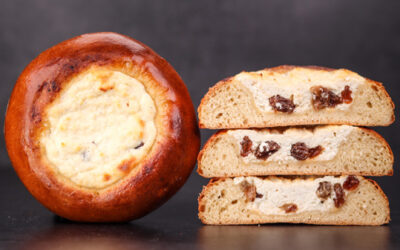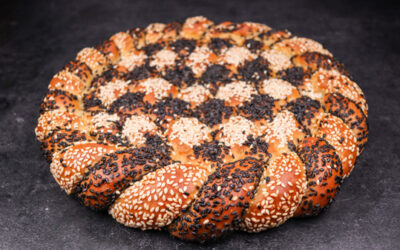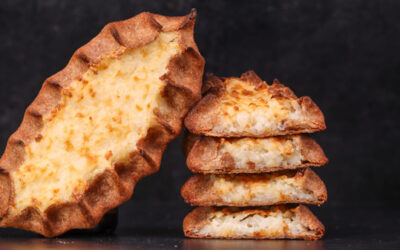Pan casero are delicious cheese filled buns commonly eaten in Bolivia.
I have seen several versions of this. Most of them simply have a little cheese or a cheese mixture spread over the top, but in this recipe, we will make a well in the dough and fill up with cheese. When it comes to cheese – the more the better is how I see it.
Making these reminded me of Norwegian custard buns which look like a sweet version of this. Breads all over the world can be remarkably similar sometimes.
I would suggest you trying both if you love soft buns with various fillings.
Besides the recipe and the delicious result, I would like to point out an important lesson here. This dough is made with a preferment or a sponge if you will. This affects the way we control the final dough temperature. Because the sponge must ferment, we use warmer liquid to get the fermentation going. This in turn will come into play once we add the rest of the ingredients and start kneading. If your preferment is warm and you add warm flour and warm egg etc., then the final dough temperature after kneading will be too high. Normally I would use cold milk to make a regular dough, and this would counteract the temperature I add during kneading. In this case the only ingredients that we can control are the remaining flour and the egg. Refrigerate them while the preferment is rising. My flour and egg were at around 13C (55F). This ensured that the final dough temperature after kneading came to be 25C (77F), which is what we normally aim for.
This goes for any bread made using a preferment.
Watch the video down below for detailed instructions.
Ingredients
For the sponge –
60g (2.1oz) strong white bread flour
3g (0.1oz) instant dry yeast 3.6g (0.12oz) active dry yeast or 9g (0.3oz) fresh yeast
100g (3.5oz) milk at around 23C (73F) if your kitchen is around 21-23C (70-73F) *
*To learn more about dough temperature control click here.
For the main dough –
190g (6.7oz) strong white bread flour
5g (0.17oz) salt
10g (0.35oz) sugar
20g (0.7oz) soft butter
1 egg, around 50g (1.75oz), cold* from the fridge. The egg and milk must add up to 150g (5.3oz). Weigh your egg first, then make up the difference with milk.
*To learn more about dough temperature when using a preferment click here.
For the filling –
120g (4.25oz) grated mozzarella
120g (4.25oz) crumbled feta
1 whole egg
1 egg yolk mixed with 1 teaspoon of milk for glazing
Method
- Mix the filling to get it out the way. Combine the cheeses and the egg. Mash everything together well with a fork. Leave in the fridge until needed.
- Make the sponge. In a bowl combine the milk, yeast, and flour. Mix it well until there are no lumps or dry flour. Leave to ferment for 45 – 60 minutes or until visibly puffed up and full of small bubbles.
- Add the egg, salt, sugar, and butter to the sponge. Mix well to dissolve any large salt and sugar crystals. Add the flour and mix to a dough.
- Tip the dough out on your table and knead for 5 minutes. *Desired dough temperature 25C (77F). If your dough is warmer, then it will ferment more rapidly. If it is cooler, then it will take longer. Adjust proofing time accordingly.
- Cover and ferment for 1 hour.
- Divide the dough into 6 equal pieces. Pre-shape into balls.
- Cover and rest for 20 minutes.
- Stretch the dough balls gently making a depression in the middle and leaving a thicker edge. Place on a non-stick paper lined tray leaving space in between.
- Cover and ferment for 1 hour. *During this time preheat your oven to 160C (320F) fan on.
- Stretch the dough out one more time and brush with the egg wash twice. Fill up with the cheese mix and spread it on evenly.
- Bake for around 25 minutes until puffed up and golden brown all over.
Enjoy!
Keep in mind that the conditions in each kitchen are different, so fermentation times may vary for you. It is up to the baker to control the bread and react accordingly.
Your oven may be different too, so your baking time may vary.
Check out more videos from the Baking World Tour.
Watch the video here



